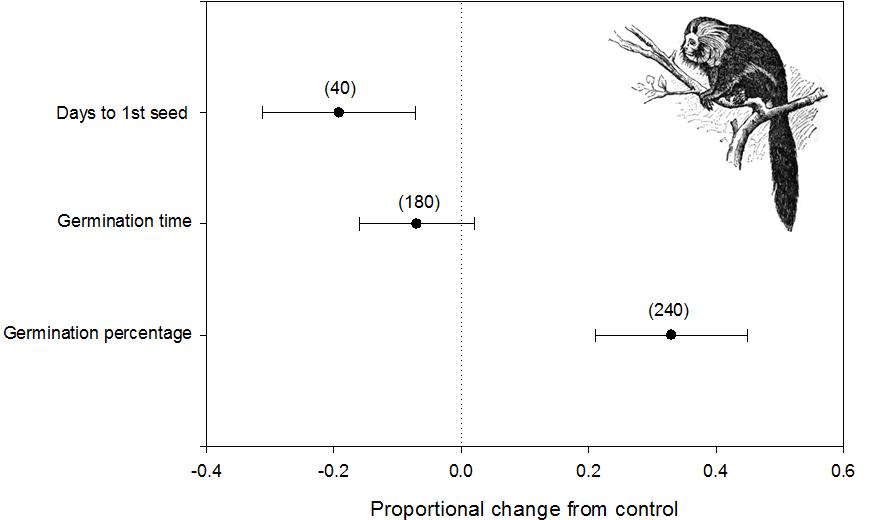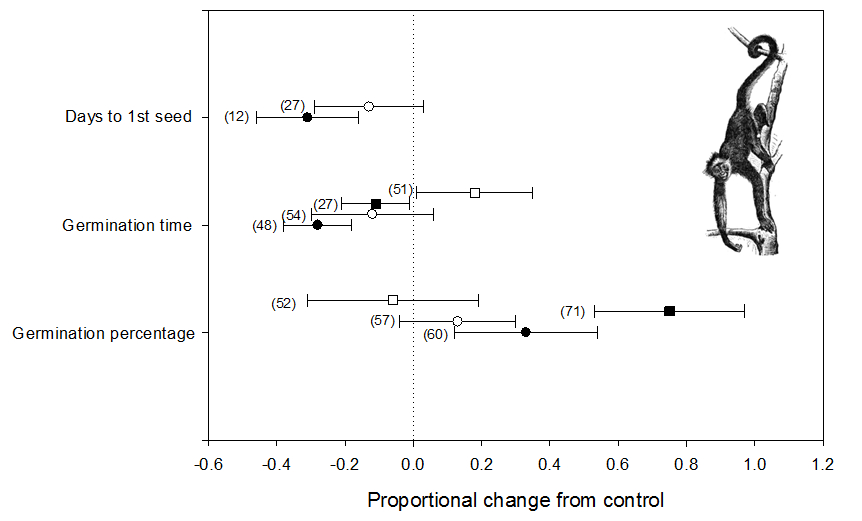What role do monkeys play in seed dispersal?
Submitted by editor on 19 January 2016. Get the paper!
Get the paper!Seed dispersal by vertebrate is a key process affecting the movement of offspring away from a parent plant. But, if plants are limited mobility, they strongly rely on the effective dispersal by vertebrates.
In addition to merely transportation, fleshy-fruited plants and frugivores have evolved a cooperation process, called mutualism. When vertebrates swallow fruits, they carry the seeds inside their guts and give them a treatment during the passage through their digestive system. Thus, most trees from tropical forests are dispersed by vertebrates (e.g. birds, bats, monkeys, tapirs, rodents).
The larger the frugivore, the more fruits it eats. Monkeys are the largest arboreal frugivores in tropical forests and are able to spread thousands or even millions of seeds per year. But, unfortunately, how seed passage through their guts affects seed germination is still not well documented. Here, we summarize available data on seed dispersal by tropical monkeys running a meta-analysis, a statistical approach that allows us to contrast results and identify patterns among different studies. Our goal is to show how germination of forest trees is affected by monkey digestive systems taking into account effects of distinct body sizes, diets and gut morphologies, which determine distinctive roles as seed dispersers. We observed significant and positive effects of passage through a monkey’s gut on seed germination percentage and on the number of days to first germination of a seed. We show a previously unrecognized positive effect of gut passage in increasing seed germination by 33% and decreasing germination time by nearly 20%, suggesting they may play a major role in forest structure, dynamics and ecosystem services. That means a third more chance of germination and much less time to germinate after been swallowed by a monkey.

Effect of passage through primate gut on germination percentage, germination time and days to first seed germinate. Numbers in parentheses indicate the number of independent comparisons for each effect and effects are significant if confidence intervals (black bars) do not overlap with zero.
In our analysis, frugivorous monkeys, those whose diets comprise 80% or more of fruits, showed the highest dispersal quality – they increased seed germination by 75%. Thus, those that depend upon fruits most heavily also provide the best dispersal service in terms of treatment in the gut. Monkeys that include more heavily on leaves in their diet, but also eat large amount of fruits, were the second-best in effectiveness: seeds germinated about 34% more and 30% faster. In contrast, primates that include a significant fraction of insects in the diet provided low dispersal quality. Insectivorous species did not affect seed germination percentage and actually delayed germination process.

Effect of passage through primate gut on germination percentage, germination time and days to first seed germinate according to primate diet (filled circle: folivore-frugivore; empty circle: frugivore-insectivore; filled square: frugivore; empty square: insectivore-frugivore). Numbers in parentheses indicate the number of independent comparisons for each effect and effects are significant if confidence intervals (black bars) do not overlap with zero.
In conclusion, tropical primates are effective mutualists of fleshy-fruited plants and they vary in their dispersing capabilities, depending upon diet and gut morphology. They promote a significant increase in seed germination and act like effective seed dispersers, which can be meaningful for the conservation of the forests. Primates represent one of the largest and dominant vertebrate dispersers in the tropical forests and it is known that their maintenance is critical for regeneration of those areas. However, forest loss, fragmentation, hunting and selective logging severely affect primate species and ecological processes involving them. We look forward to future increases in our understanding of the role of various animal taxa in supporting the diversity and regeneration of rich and peculiar and areas, such as tropical forests.